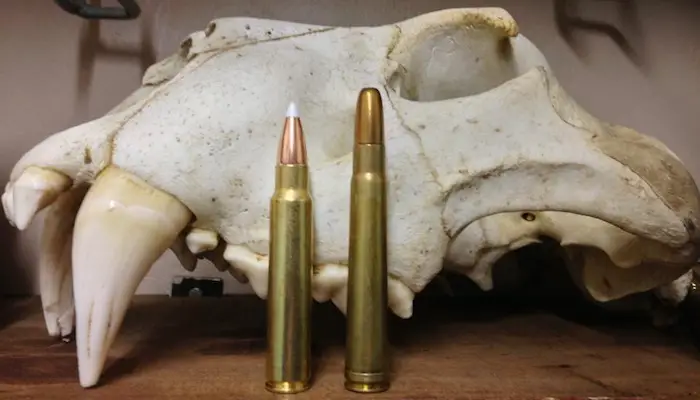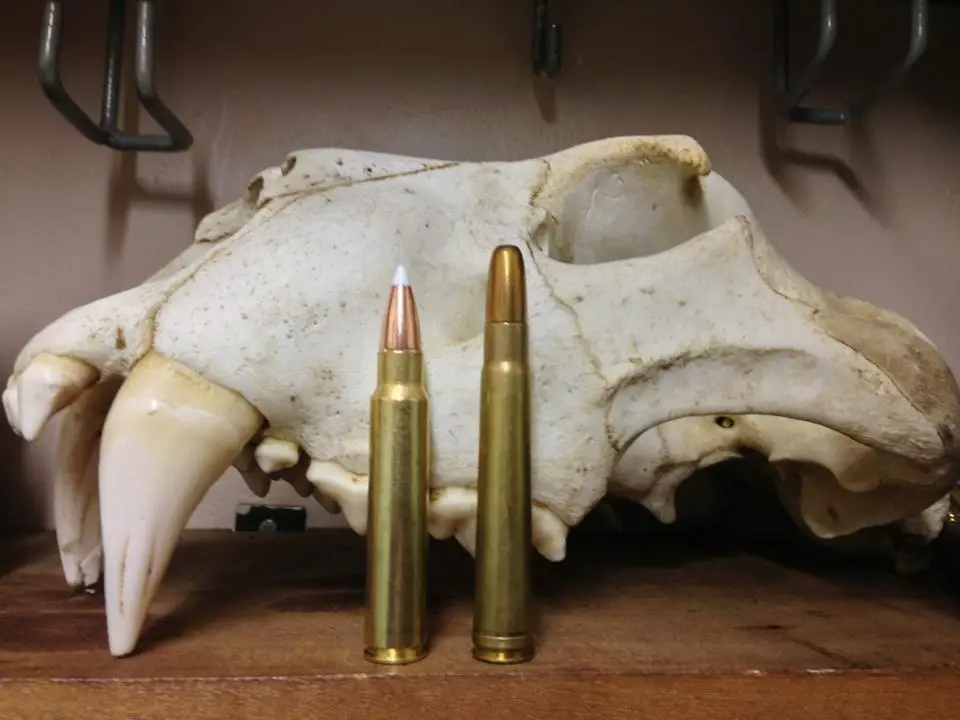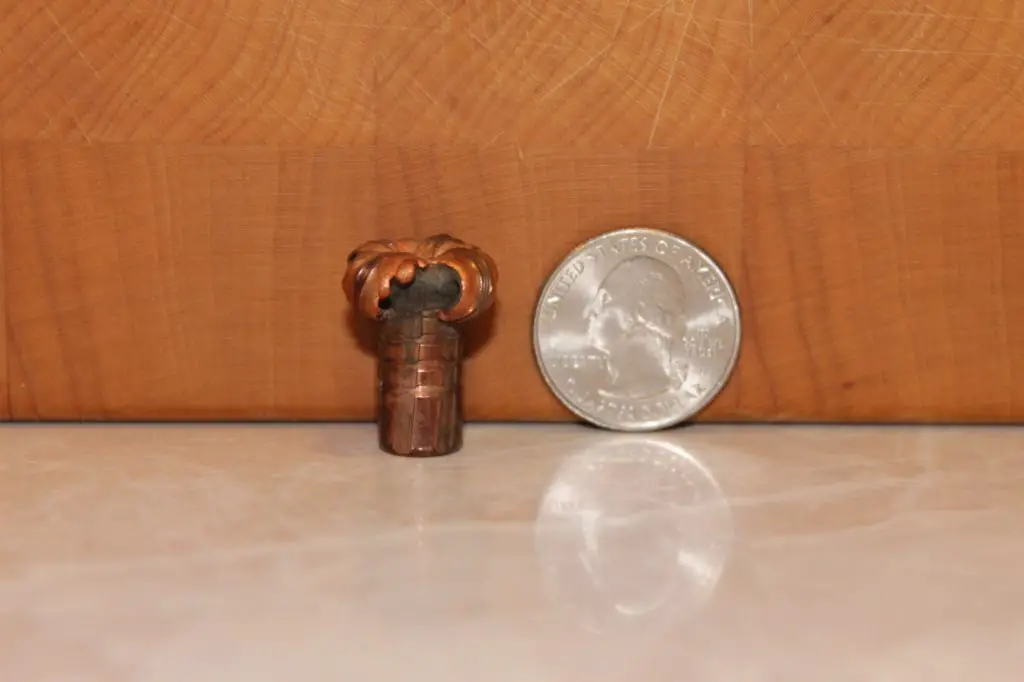Keep reading to learn all about the .375 Ruger cartridge.
The venerable .375 H&H Magnum has been the most popular dangerous game cartridge in the world for over 100 years. During its long reign, there have been many cartridges developed and marketed as competitors to the legendary .375 that just didn’t quite measure up and eventually fell by the wayside.
The .375 Ruger is the latest contender for the crown and just might succeed where the others have failed. Why is this the case? Though there are many things to like about the .375 Ruger, the major selling point of this fantastic cartridg
e is that it’s the first cartridge to deliver performance comparable to the .375 H&H from a standard length (instead of a magnum length) case. Continue reading to learn all about the .375 Ruger and why it is such a unique cartridge.
Note: some of the links below are affiliate links. This means I will earn a small commission (at no extra cost to you) if you make a purchase. This helps support the blog and allows me to continue to create free content that’s useful to hunters like yourself. Thanks for your support.
History Of The .375 Ruger Cartridge
Developed in a joint venture between Ruger and Hornady, the .375 Ruger was first introduced to the shooting public in 2007. The idea was to create a cartridge similar in length to the .30-06 Springfield, but with a case capacity comparable to the .375 H&H. By using a straight, unbelted case with a non-rebated .532″ rim, they were able to accomplish their goal.
In fact, they were able to exceed expectations because the slightly fatter and non-tapered 65.53mm (p133) .375 Ruger case actually has approximately 5% more case capacity than the 72.39mm case (p131) used by the .375 H&H.
For this reason, the .375 Ruger compares very favorably to the .375 H&H and both cartridges perform at an almost identical level ballistically. Like the .375 H&H, the .375 Ruger is accurate, powerful enough to quickly and ethically kill virtually any species of big game, and has a manageable amount of recoil that most shooters can handle. Considering the reputation of the .375 H&H, this is high praise indeed.
In fact, most .375 Ruger loads actually slightly exceed the velocities delivered by standard .375 H&H loads when shooting the same weight bullet. However, this velocity edge is small enough that it doesn’t make much of a difference in reality.
The .375 H&H is already a capable cartridge at extended range and while the .375 Ruger is a marginal improvement, the difference in trajectory between the cartridges is small. At the same time, the extra velocity doesn’t make it much better at killing game, and I doubt any animal can tell the difference between a bullet fired at 2,700fps vs 2,800fps.
However, this sight velocity advantage can allow rifles chambered in .375 Ruger to use shorter barrels and still have ballistics that are nearly the same as the .375 H&H. When you combine this with the fact that the .375 Ruger fits in a shorter action, it allows hunters to use rifles that are shorter, lighter, and handier than comparable rifles chambered in .375 H&H.
The shorter length of the .375 Ruger case is the primary selling point of the cartridge and, since the cartridge basically mirrors the .375 H&H in performance, the shorter case is a significant advantage. Instead of being restricted to using only the larger, more expensive magnum length action rifles, the .375 Ruger opens up a whole line of great quality, commercially successful, standard length action rifles that may be adapted for the cartridge and repurposed for dangerous game.
It’s hard to understate this point. Indeed, it’s possible to buy a 375 Ruger rifle for significantly less today than is the case for one chambered in .375 H&H Magnum.
.375 Ruger Loads
At this time, Hornady and DoubleTap are the only two manufacturers that produce factory loaded .375 Ruger ammunition.
Hornady loads their 250gr GMX, 270gr SP-RP, and 300gr DGX/DGS bullets to advertised velocities of 2,900fps, 2,840fps, and 2,660fps respectively (using a 24″ barrel). DoubleTap currently offers loads with 260gr Nosler Accubond along with 235gr and 270gr Barnes TSX bullets with advertised loads of 2,900fps, 3,100fps, and 2,825fps respectively (using a 23″ barrel).
Even though there aren’t many choices out there when it comes to factory ammunition, the good news for hand-loaders is that the .375 Ruger can be reloaded using just about any of the vast number of different .375 bullets on the market originally designed for the .375 H&H. For instance, hand-loaders have bullets like the Barnes Triple Shock, Nosler Partition, and the Hornady DGS/DGX (just to name a few) to choose from. The other good news is that it is possible for hand-loaders to safely duplicate factory ammo performance of the cartridge using commercially available powders.
The .375 Ruger is also a pretty accurate round, particularly when used in a good quality rifle. Even though it was not designed as such, it is still a capable extended range cartridge in the right hands. Especially when using lightweight bullets, a 250-350 yard shot (perhaps even further) is well within the capabilities of the cartridge.
That being said, most hunters utilize the cartridge in such a way that the vast majority of their shots are taken at ranges less than 150 and often less than 100 yards. Under these conditions, the .375 Ruger excels and the fact that the rifles it is typically used in are often shorter and faster pointing really becomes an asset.
BUY SOME QUALITY 375 RUGER HUNTING AMMO HERE
The .375 Ruger unquestionably produces more recoil than both the .375 H&H and the 9.3x62mm Mauser. However, the recoil, while stout, is still manageable for most hunters.
Hunting With The .375 Ruger
Like the .375 H&H, the .375 Ruger is an incredibly versatile cartridge.
With factory loads that produce well in excess of 4,500 foot pounds of energy, the cartridge meets the legal requirements to hunt members of the African Big 5 and other species of dangerous game in virtually every country in the world. It is absolutely deadly on a wide range of animals varying in size from whitetail deer all the way up to elephant.
The heavier 270gr and 300gr loads are particularly versatile and are well suited both for larger game like water buffalo, kudu, eland, cape buffalo, brown bear, grizzly bear, and moose as well as small/medium sized game like impala, wildebeest, deer, feral hogs, and black bear. Heck, the .375 Ruger shoots flat enough that it’s even suitable for longer range shots, like those you might need to take on a red stag or caribou during a Canada or New Zealand hunting expedition.
The cartridge also shoots flat enough that it is possible to confidently take shots out to 250 yards or so without adjusting the point of aim. As you can see in the impala, blesbok, and black wildebeest hunting videos below, it still packs quite a punch at 200+ yards.
As the saying goes, the proof is in the pudding and more and more hunters are starting to realize what a fantastic cartridge the .375 Ruger is. The cartridge, particularly when used in the handy Ruger Guide Gun with its 20″ barrel, is starting to develop quite a following among guides and professional hunters in Africa and Alaska who want a powerful, fast pointing rifle to use at close range on angry dangerous game, like bear and cape buffalo.
It cannot hold a candle to the .375 H&H in terms of popularity or availability of ammunition, especially in remote locations, but the .375 Ruger is catching up fast and ammunition is much more common than it was even a few years ago.
Indeed, it is arguably one of the best rifles for hunting Africa.
In that vein, a PH friend of mine in South Africa has a Ruger Guide Gun chambered in .375 Ruger that he purchased back in 2016. He primarily uses it as a client rifle and he and his clients combined have put over 3,000 rounds through that rifle and have taken virtually everything from klipspringer and duiker all the way up to hippopotamus and cape buffalo during the course of the 7 years he’s owned it.
The .375 Ruger is a great cartridge, but I don’t see it supplanting the .375 H&H as the most popular dangerous game cartridge anytime soon. Even though it has a number of advantages over the .375 H&H on paper, performance in the real world is not the same as performance on paper.
The cartridge is certainly coming along and developing a growing following. However, the .375 H&H has been around for more than a century and has a stellar reputation among hunters. It is going to take many years of great performance before people feel the same way about the .375 Ruger (if they ever do).
Is the .375 H&H dead? Not by a long shot. Do you need to dump your .375 H&H and get a .375 Ruger? Not necessarily. That being said, if you’re looking for a single cartridge to hunt the widest variety of big game possible, then a good rifle chambered in .375 Ruger just might be the right choice for you.
To that end, I recorded an entire podcast episode on classic Africa hunting cartridges with renowned Professional Hunter and author Kevin Robertson. In this episode, we talk about the pros, cons, and recommended uses for almost everything from the 243 Winchester all the way up to the 600 and 700 Nitro Express (to include the 375 Ruger).
This is a fantastic episode, so just click the appropriate link below to listen to our discussion on your preferred podcast app. Be sure to hit that “Subscribe” or “Follow” button in your podcast app to receive future episodes automatically (for free)!
Classic Africa Hunting Cartridges Podcast
Apple | Google | iHeart | Spotify
Enjoy this article about the .375 Ruger? Please share it with your friends on Facebook and Twitter.
The Lyman 50th Edition (p325-326) and Hornady 10th Edition (p713-716) reloading manuals were used as references for this article.
Make sure you follow The Big Game Hunting Blog on Facebook, Instagram, Twitter, and YouTube.
NEXT: 6 GUNS EVERY HUNTER SHOULD OWN
NEXT: 101 BEST GIFTS FOR HUNTERS
John McAdams is a proficient blogger, experienced shooter, and long time hunter who has pursued big game in 8 different countries on 3 separate continents. John graduated from the United States Military Academy at West Point and is a veteran of combat tours with the US Army in Iraq & Afghanistan. In addition to founding and writing for The Big Game Hunting Blog, John has written for outdoor publications like Bear Hunting Magazine, The Texas State Rifle Association newsletter, Texas Wildlife Magazine, & Wide Open Spaces. Learn more about John here, read some of John’s most popular articles, and be sure to subscribe to his show: the Big Game Hunting Podcast.





Law of physics would seem to dictate that the recoil from a 375 Ruger is virtually the same as that sustained from a 375 H&H, yes? However, if it is being used more widely in the shorter barreled rifles (e.g., M77 Hawkeye Guide Gun), which presumably are lighter than standard 375 H&H rifles, then is it logical to say the 375 Ruger tends to produce more recoil? I only have a 375 H&H (CZ) and never shot a 375 Ruger, though I’d like to.
I know this is 3 years old but…I own a 375 Ruger in the Savage 110 platform. It is fairly light and definitely handy. Ive not shot a full size 375 H&H but I can say despite being 8lbs with Leupold scope, with full loads of 300 grain bullets it will recoil much less than my 458 Lott in 9.5lb gun.
I think that’s fair. With a shorter and lighter chassis in combine with slightly more energy at ignition the difference in felt recoil would be exactly that, felt! However, I’m still willing to agree on faith that the net impact is manageable and certainly worth the advantages in trade off.
That’s essentially been my experience with it. The .375 Ruger recoils a little more than the .375 H&H to be sure, but it’s a negligible difference. There’s nothing wrong with using the .375 H&H, but I feel like the slight improvement in performance the .375 Ruger offers is worth the additional recoil.
The 9,3×62 (.366) is as good , if not better than the .375 Ruger !
I took an Alaskan to RSA last year for a plains game safari. Zebra (first shot knocked him down, when he got back up the 2nd round broke both shoulders, 3rd finisher), Impala (one shot – DRT), Gemsbok (one shot and went 100 yards), Kudu (one shot – went 35 yards), Warthog cull (one shot 75 yards running), Blue Wildebeest (one shot – went 200 yards), Blesbok (first shot dropped, 2nd shot to finish), Giraffe (first shot in heart, 2nd in shoulder – went 50 yards), 2xBaboon (1st one was 200 yards running – one shot; 2nd was 50 yards sitting – one shot). The synthetic Hogue overloaded stock seems to soak up a good deal of the recoil – the rubber coating helps, the straight/high comb helps, and the pistol grip area allows one to pull the rifle into he shoulder effectively. I shot 270 TSX and only recovered the round from the Gemsbok, the finisher from the Zebra, and the rounds from the Giraffe. The 100 yard shot on the Giraffe just made it through the heart to the far side, losing 1 petal about and inch inside of the far side of the heart. The second round went into the shoulder after he started his death run and it never made it into the chest cavity. This platform and cartridge are my favorite. It has a VX-5HD 1-5×20 firedog from Leupold with the customer dial system cap. Short, handy, and enough power. Never noticed recoil in the field, and I can shoot 50 round training sessions.
The 375 Ruger is a great Hunt The World Cartridge! The key word is hunting and not Sniping. Depending
upon your rifle and load, out to 400+ yards is realistic! So long as one knows the chosen bullet performance window. For an example, the 270 grain Interlock expands reliably down to 1950 fps. Actually the 375 Ruger would be a great choice, for the one rifle hunter and is why I’m building one. Reloading for it too. I wanted a light 375 and had a stainless 338 Tikka T3 bored out to 375 Ruger, by JES of Oregon. Yes, 3 rounds fit and feed from factory magazine. But now I’m taking things to the next level. I’m going to use prefit 375 carbon fiber Tikka barrels, prefit or Remmage style. On order. One will be 24 inch for longer shots and the other 18 inches for close range work. I can swap barrels as fancied. For the stock I ordered a Mesa Precision Altitude. I’m using other aftermarket parts such as, factory style bottom metal, aluminium schraud, metal Mags and possible ARCA rail. Each barrel will have its own scope with WARNE QR rings. I just like having this rig, knowing I can hunt The Globe. Should longer range shots be called for, my 300 RUM will come out to play! 375 Ruger and 300 RUM are my favorite hunting cartridges. Lastly… I disdain brakes, do not fear recoil and could care less about cartridge effiency. I want performance, which is one advantage hunting these days.